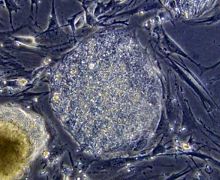 Embryonic stem-cell research would get a financial boost under a new proposal by the National Institutes of Health. According to the Wall Street Journal, the NIH guidelines expand funding for cell lines derived from surplus human embryos (those left over from fertility treatments). During the Bush era, the NIH funded 21 cell lines obtained from leftover human embryos. Acting NIH director Raynard Kingston estimates that there are an additional 700 cell lines available, many of which would be eligible for funding under the new proposal.
Embryonic stem-cell research would get a financial boost under a new proposal by the National Institutes of Health. According to the Wall Street Journal, the NIH guidelines expand funding for cell lines derived from surplus human embryos (those left over from fertility treatments). During the Bush era, the NIH funded 21 cell lines obtained from leftover human embryos. Acting NIH director Raynard Kingston estimates that there are an additional 700 cell lines available, many of which would be eligible for funding under the new proposal.
The NIH maintained restrictions against cell lines obtained by more controversial means. The proposal restricts funding on cell lines derived from cloned embryos, embryos created specifically for research, and embryos created by parthenogenesis. The guidelines also require that women or couples who donate surplus embryos do so under consent procedures that will be drafted by the NIH.
The guidelines were drawn up in response to an executive order from President Barack Obama. They are still in draft form and are available for public review at the NIH website. At the draft’s time of publication in the Federal Register (expected on April 24), the NIH will post a URL where comments can be submitted electronically for a 30-day period.